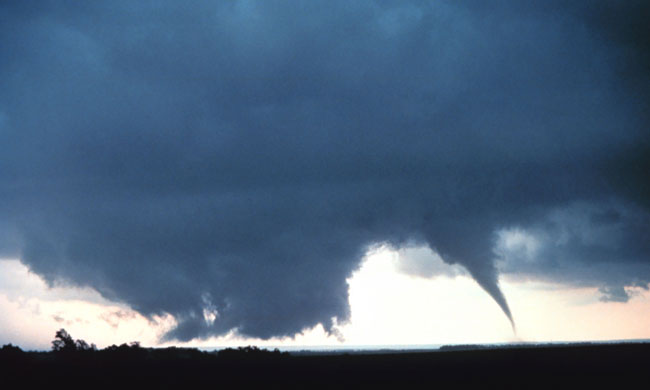Hurricanes Spawning More U.S. Tornadoes

Tornadoes that are spun off by hurricanes as they make landfall are on the rise, a new study finds.
The spike in twisters seems to be related to the increase in size and frequency of land-hitting hurricanes in the Gulf of Mexico.
"As the size of landfalling hurricanes from the Gulf of Mexico increases, we're seeing more tornadoes than we did in the past that can occur up to two days and several hundred miles inland from the landfall location," said study researcher James Belanger, a Georgia Tech graduate student.
Radar records
Meteorologists have long known that when hurricanes hit land, there's a risk that tornadoes may form in the area. But just how high or low that risk might be was hard to determine, because records of such tornadoes were sporadic.
Now, with observations from the NEXRAD Doppler Radar Network, installed in 1995, a group of scientists at Georgia Tech can more accurately pin down that risk.
The researchers developed a model for hurricane-induced tornadoes that uses four factors that serve as good predictors of tornado activity: size, intensity, track direction and whether there’s a strong gradient (or rate of change) of moisture at mid-levels in the storm's environment.
Get the world’s most fascinating discoveries delivered straight to your inbox.
"The size of a tropical cyclone [the term for all hurricanes, typhoons and tropical storms] basically sets the domain over which tornadoes can form. So a larger storm that has more exposure over land has a higher propensity for producing tornadoes than a smaller one, on average," Belanger said.
The team looked at 127 tropical cyclones from 1948 up to the 2008 hurricane season and went further back to 1920 modifying their model to account for the type of data collected at that time.
They found that since 1995 there has been a 35 percent increase in the size of tropical cyclones from the Gulf compared to the previous active period of storms from 1948-1964, which has led to a doubling in the number of tornadoes produced per storm.
The number of hurricane-induced tornadoes during the 2004 and 2005 hurricane seasons (the latter of which produced Hurricane Katrina) is unprecedented in the historical record since 1920, according to the model.
Testing predictions
To test how well the model predicted the number of tornadoes associated with a given hurricane, they input the intensity of the storm at landfall, its size, track and moisture at mid-levels, and were able to generate a forecast of how many tornadoes formed from the hurricane.
They found that for Hurricane Ike, which drenched Galveston, Texas, in 2008, their model predicted exactly the number of tornadoes that occurred, 33. For Hurricane Katrina in 2005, the model predicted 56 tornadoes, and 58 were observed.
The team's next steps are to take a look to see how hurricane size, not just intensity (as indicated by the Category 1 to 5 Safir-Simpson scale of hurricane strength), affects the damage experienced by residents.
"Storm surge, rain and flooding are all connected to the size of the storm," said study team member Judith Curry, chair of the School of Earth and Atmospheric Sciences at Tech. "Yet, size is an underappreciated factor associated with damage from hurricanes. So it's important to develop a better understanding of what controls hurricane size and how size influences hurricane damage."
Ike provides a case-in-point: "The great damage in Galveston from Hurricane Ike in 2008 was inconsistent with Category 2 wind speeds at landfall, but it was the large size that caused the big storm surge that did most of the damage," Curry said.
The study was detailed in the Sept. 3 issue of the journal Geophysical Research Letters.
- Video – Tornado Chasers in Action
- Tornado News, Information and Images
- 12 Twisted Tornado Facts



